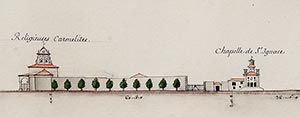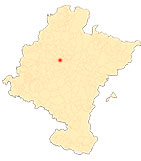Basilica of St. Ignatius of Loyola
By Ricardo Fernández Gracia
|
|
|
|
|
|
|
|
|
|
|
|
|
|
|
|
|
|
|
|
|
|
|
|
|
|
|
|
|
|
|
|
|
|
|
18th century projects
-
1704: the chaplain's house was built.
-
1718-1720: ornamentation with plasterwork costing 210 reales (mason), 1,249 (carver), 176 (lumps), 458 (painter), 770 (colors), 108 (whitewasher) and 75 (scaffolding).
-
1721: construction of the fence.
-
1726: main altarpiece.
-
1747: lawsuit with the Discalced Carmelite nuns
-
1753: The bishop asked the king for land adjacent to the basilica for the construction of a retreat house and a nobleman's seminar with its church. The basilica turned out to be small, and the house was to house average dozen Jesuits. The bishop had the consent of the general and contributed 4,000 pesos for the project.
-
The City Council reported favorably, but not the Descalzas.
-
The land was given.
-
1760: project Roman to make the temple new.
-
The arrival of Charles III resulted in 1760 with the cancellation of the ownership of the land.
-
1767: Expulsion of the Jesuits.
The last years of the Jesuits' presence in Pamplona were marked by the attempt to build an exercise house and a nobles' seminar next to the basilica. The civil service examination of the Carmelites and the arrival of Carlos III to the throne frustrated the project, for which plans from Rome were required. The famous Father Sebastián de Mendiburu had already secured the sum of 20,000 pesos.
The Roman project for the Basilica of St. Ignatius of Pamplona is documented around 1760 in the following letter from Father Eugenio Colmenares to the Provincial of Castile, which we transcribe in its entirety for its interest:
My Father President, I have consulted about the construction of the basilica and all the Fathers agreed with the idea, and that the construction should begin with those funds, following the plan that came from Rome. It only seemed to them that it would be convenient to begin the construction before demolishing the old chapel on the part that falls toward the door of the Discalced Carmelite nuns to ensure that there is no civil service examination in the said work. Also, it is procured to go of agreement with the viceroy and the governor of the place so that they do not leave later if it embarks or it does not embark or it impedes the handling of the fortifications and your reverences are seen pregnant in some lawsuit. And, finally, that it is not said that Jesuits who form a community are to live there, but that they will go from the high school to give the exercises when there are exercitantes, lest the communities revolt. And your reverences will find your reverences without continuing the work and without a chapel if the old one is demolished immediately. I suppose that your reverence will foresee all these inconveniences and those that may occur.
May your reverence and God keep you for many years, as I beseech. Valladolid and January 25, 1765.
Most affectionate servant of your reverence, IHS, Eugenio Colmenares.
file Diocesan of Pamplona. Government of the Diocese. administrative office de Cámara. Boxes 293, 294, 295, 296 and 297.
ASCUNCE, E., Íñigo de Loyola, capitán español, y el castillo de Pamplona, Madrid, Aguado, 1939.
AZANZA LÓPEZ, J., La arquitectura religiosa del Barroco en Navarra, Pamplona, Government of Navarre, 1998.
EGUILLOR, J. R., Loyola, historia y arquitectura, San Sebastián, Etor, 1991.
FERNÁNDEZ GRACIA, R., El retablo barroco en Navarra, Pamplona, Government of Navarre, 2003.
FERNÁNDEZ GRACIA, R., "The Jesuits in Pamplona 1580-1767". Diario de Navarra, 28 April 2014, pp. 70-71.
FERNÁNDEZ GRACIA, R., "Heritage and identity (52). The basilica of San Ignacio in Pamplona". Diario de Navarra, 21 May 2021, pp. 62-63.
GARCÍA GAÍNZA, M.ª C. et al., Catalog Monumental de Navarra V. Merindad de Pamplona ***, Pamplona, Institución Príncipe de Viana, 1997.














